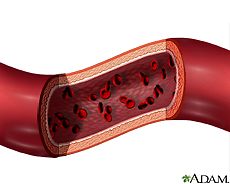 |
 |
 |
||
    |
||||
|
||||
|
Other Health Topics:
Thalassemia
Also called: Cooley's anemia, Mediterranean anemia
If you have thalassemia, your body has problems making hemoglobin, the protein in red blood cells that carries oxygen through your body. When your blood does not carry enough oxygen to the rest of your body, you have anemia. Thalassemia, a genetic disease, can be mild or severe. Some carriers of the gene have no symptoms. The most common severe form in the United States is a type called Cooley's anemia. It mainly affects people of Mediterranean or Asian ancestry. It usually appears during the first two years of life. Severe thalassemia is treated with blood transfusions and treatment to remove excess iron in the blood. National Heart, Lung, and Blood Institute
Start Here
|
| Home | Health Topics | Drugs & Supplements | Encyclopedia | Dictionary | News | Directories | Other Resources | |
| Disclaimers | Copyright | Privacy | Accessibility | Quality Guidelines U.S. National Library of Medicine, 8600 Rockville Pike, Bethesda, MD 20894 National Institutes of Health | Department of Health & Human Services |
Date last updated: 13 April 2009 Topic last reviewed: 08 April 2009 |


